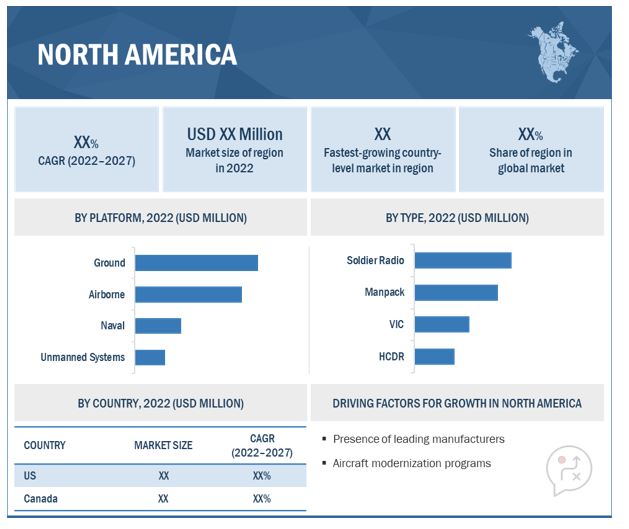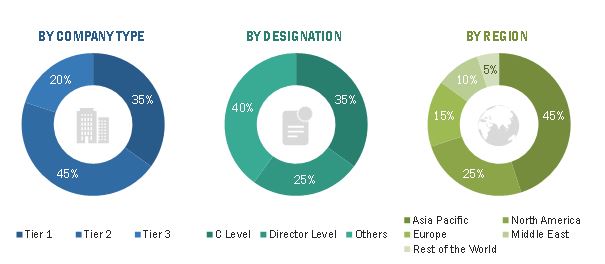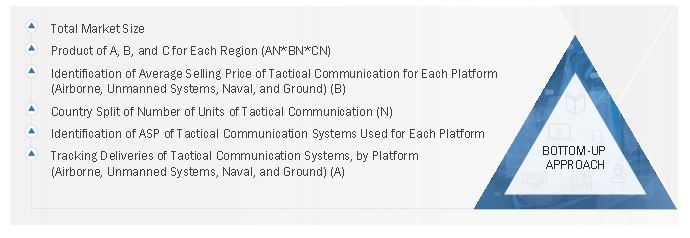Tactical Communication Market by Type (Soldier Radios, Manpacks, VIC, HCDR), Application (Command & Control, ISR, Communication, Combat), Platform, Frequency, Technology, Point of Sale, and Region -Global Forecast to 2027
Update: 10/22/2024
Tactical Communication Market Size and Share
[236 Pages Report] The Tactical Communication Market Size is estimated to be USD 12.5 billion in 2022 and is projected to reach USD 16.0 billion by 2027, at a CAGR of 4.9% from 2022 to 2027. The Tactical Communication Industry Share is driven by factors such as transition of radio communication devices from analog to digital, customized communication on the move solutions for unmanned ground vehicles, etc.

To know about the assumptions considered for the study, Request for Free Sample Report
The COVID-19 Outbreak has caused multiple challenges for defense industry. Though the industry was not severely affected but still has faced many economic downturns. The global manufacturing of tactical communication, components, and assembly lines have been impacted. The military budget allotted to the defense sector has been reduced by several countries due to the COVID-19 pandemic. This puts most research projects on hold. The export of tactical communication systems to several countries in the Middle East, Africa, and Latin America has also been reduced. All these scenarios affect the development of tactical communication.
Tactical Communication Market Dynamics
Drivers: Transition of radio communication devices from analog to digital
Due to advancements in software-defined platforms, land mobile radio products have transitioned from analog to digital. The rising demand for digitalized products and standards, including DMR, TETRA, and P25, owing to the various advantages over analog products, is expected to lead to the growth of the tactical communication market. Digital devices offer robust communication experiences and higher spectrum efficiency that facilitate machine-to-machine (M2M) and high-end IoT applications. Such digital systems can also support both, voice and data services such as M2M applications on highly reliable networks, providing coverage across a large service territory. The growing significance of digital radio systems, coupled with their advantages over analog systems, are expected to lead to market growth during the forecast period.
Restraints: Growing security concerns
The chances of a security breach are high when installing or loading new software in a tactical communication unit through an over-the-air update. There is high possibility of unauthorized and potentially malicious software being installed on the specified platform. The process is similar to the installation of software on laptops or personal computers wherein the prevention of any malicious functions is required.
Concerns related to unlicensed codes restrict market growth owing to the potential for compromising the security of the users’ assets along with threats to the communication capabilities of devices. Such security concerns are expected to lead to barriers to the growth in the sales of communication systems, including advanced tactical software-defined radios. Thus, security concerns act as a key restraining factor for the growth of the tactical communication market.
Opportunities: Demand for next-generation IP radio systems
Companies are focusing on increasing profitability by offering consumers a wide range of advanced IP radio systems due to the increasing demand across the globe. Sales of such products are also expected to provide new or enhanced services for the networking industry while at the same time, reducing transaction costs and further enhancing the end user experience. Next-generation frontline mobile communications also tend to shift away from high power single line contact methods towards mesh systems with low power, which enable higher numbers of operators to be linked together by means of multi-node mesh systems. Such systems have low susceptibility towards failures in single points and are also capable of self-healing, thereby enabling the communication packets to find the best transfer routes based on available system bandwidth and traffic levels. These next-generation IP radio systems are expected to provide opportunities for the usage of advanced tactical communication.
Challenges: High power consumption
Power consumption is considered to be one of the key challenges for the tactical communication industry. Tactical radios generally require high power for a specific function compared to other equipment designed specifically for analog or digital architectural partitioning. High power consumption is majorly challenging for small handheld radios and manpack radio units. The rapidly evolving field programmable gate arrays (FPGAs), digital signal processors (DSPs), and enhancements in parallel computation have helped increase the performance of communication systems.
Various technologies can be utilized in tactical communication radios including application-specific integrated circuits (ASICs), DSPs, general purpose processors (GPPs), and FPGAs. The GPP technology offers higher flexibility with low performance results in high power consumption, creating a challenge for market growth. However, the ASIC technology which delivers the least flexibility and high-performance can be used to minimize power consumption and maximize performance. Thus, reducing the high power consumption of various tactical radios is expected to be a challenge for the industry.
Tactical Communication Market Segments
Ground segment of the Tactical Communication Market by platform, to grow at highest market share during the forecast period
Based on platform, the ground segment is projected to grow from USD 5,131 million in 2022 to USD 6,601 million by 2027, at a CAGR of 5.2% during the forecast period. The growth can be attributed to the increasing demand of UGVs for both military application.
Soldier Radios segment to command the Tactical Communication Market Size by type, during the forecast period
Based on type, the Soldier Radios segment is projected to grow from USD 4,178 million in 2022 to USD 5,412 million by 2027, at a CAGR of 5.3% during the forecast period. The growth can be attributed to the higher adoption of technologically advanced Tactical Communication products owing to the ease of operation and maintenance.
Upgradation segment to dominate the Tactical Communication Market by point of sale, during the forecast period
Based on point of sale, the upgradation segment is projected to grow from USD 7,161 million in 2022 to USD 9,212 million by 2027, at a CAGR of 5.2% during the forecast period.
Tactical Communication Market Regions
The North America market is projected to contribute the largest market share from 2022 to 2027

To know about the assumptions considered for the study, download the pdf brochure
Emerging Industry Trends
GNU RADIO
GNU radio is one of the open-source software development frameworks or toolkits available for SDRs. It is one of the powerful frameworks for the streaming, development, and real-time signal processing of Software Defined Radio on general processors. This toolkit provides signal processing blocks for the implementation of software-defined radios. GNU radio can be used with readily available low-cost external RF hardware to create software-defined radios, or without hardware in a simulation-like environment. It is widely used in the research, academia, and government sectors.
Tactical Communication Companies: Top Key Market Players
The Tactical Communication Companies is dominated by globally established players such as:
- Collins Aerospace (US)
- L3harris Technologies (US)
- Northrop Grumman Corporation (US)
- Thales Group (France)
- General Dynamics Corporation (US)
The report covers various industry trends and new technological innovations in the Tactical Communication Market for the period, 2018-2027.
Scope of the report
|
Report Metric |
Details |
|
Estimated Market Size |
USD 12.5 billion in 2022 |
|
Projected Market Size |
USD 16.0 billion by 2027 |
|
Growth Rate |
4.9% |
|
Market size available for years |
2018–2027 |
|
Base year considered |
2021 |
|
Forecast period |
2022-2027 |
|
Forecast units |
Value (USD Million/Billion) |
|
Segments covered |
By Platform, By Application, By Type, By Frequency, By Technology, By Point of sale |
|
Geographies covered |
North America, Europe, Asia Pacific, Rest of the World. |
|
Companies covered |
L3harris Technologies (US), Honeywell International Inc (US), General Dynamics Corporation (US), Lockheed Martin Corporation (US), Northrop Grumman Corporation (US), Leonardo S.p.A. (Italy), BAE Systems (UK), among others. (23 Companies) |
The study categorizes the Tactical communication Market based on platform, application, type, technology, and region
By Platform
-
Ground
- Ground Control Stations/Command Centre
- Armored vehicles
- Soldiers
-
Airborne
- Fixed
- Rotary
-
Naval
- Ships
- Submarines
-
Unmanned Systems
- Unmanned Ground Vehicles (UGVs)
- Unmanned Aerial Vehicles (UAVs)
- Underwater Vehicles
By Application
- Command & Control
- Intelligence, Surveillance & Reconnissance
- Communication
- Combat
By Type
- Soldier Radios
- Manpacks
- Vehicular Intercommunication Radio (VIC)
- High Capacity Data Radio (HCDR)
By Frequency
- Single Frequency
- Multi Frequency
By Technology
- Time division multiplexing (TDM)
- Next generation network (NGN)
By Point of Sale
- New Installations
- Upgradation
By Region
- North America
- Europe
- Asia Pacific
- Rest of the World
Recent Developments
- In May 2022, Thales was one of two (2) vendors awarded an Indefinite Delivery, Indefinite Quantity (IDIQ) contract by the US Army to deliver advanced tactical radios under the US Army’s Combat Net Radio (CNR) modernization program. The competitive 10-year contract for the Combat Net Radio (CNR) program includes a five-year base ordering period and an additional five-year optional ordering period.
- In May 2022, L3Harris Technologies received an IDIQ contract increase for its Falcon IV AN/PRC-167 radio systems from the US Special Operations Command (USSOCOM). USSOCOM increased the initial IDIQ ceiling from USD 255 million to USD 552 million.
Frequently Asked Questions (FAQ):
What are your views on the growth prospect of the Tactical Communication Market?
Response: The Tactical Communication Market is expected to grow substantially owing to the technological development in designing of the various tactical communications and related components for several military applications.
What are the key sustainability strategies adopted by leading players operating in the Tactical Communication Market?
Response: Key players have adopted various organic and inorganic strategies to strengthen their position in the Tactical Communication Market. Major players, including Collins Aerospace (US), L3harris Technologies (US), Northrop Grumman Corporation (US), Thales Group (France), and General Dynamics Corporation (US) have adopted various strategies, such as contracts and agreements, to expand their presence in the market further.
What are the new emerging technologies and use cases disrupting the Tactical Communication Market?
Response: Some of the major emerging technologies and use cases disrupting the market include development of compact Tactical Communication products, development of cognitive radios, etc.
Who are the key players and innovators in the ecosystem of the Tactical Communication Market?
Response: Major players, including Collins Aerospace (US), L3harris Technologies (US), Northrop Grumman Corporation (US), Thales Group (France), and General Dynamics Corporation (US).
Which region is expected to hold the highest market share in the Tactical Communication Market?
Response: Tactical Communication Market in the North America region is estimated to account for the largest share of 48.9% of the market in 2022 and is expected to grow at the highest CAGR of 6.0% during the forecast period.
To speak to our analyst for a discussion on the above findings, click Speak to Analyst

The study involved four major activities in estimating the current size of the tactical communication market. Exhaustive secondary research was done to collect information on the market, peer market, and parent market. The next step was to validate these findings, assumptions, and sizing with industry experts across the value chain through primary research. Both top-down and bottom-up approaches were employed to estimate the complete market size. After that, market breakdown and data triangulation were used to estimate the market size of segments and subsegments.
Secondary Research
The market share of companies offering tactical communication systems was arrived at based on the secondary data available through paid and unpaid sources and analyzing the product portfolios of major companies and rating them based on their performance and quality. In the secondary research process, sources such as government databases; SIPRI, corporate filings such as annual reports, press releases, and investor presentations of companies; white papers, journals, and certified publications; articles by recognized authors; and directories and databases were used to identify and collect information for this study.
Secondary research was mainly used to obtain key information about the industry’s value and supply chain. Secondary research was also used to identify the key players through the various products offered, market classifications, and segmentation. Secondary information helped in understanding the different industry trends related to tactical communication components, platforms, frequencies, data link types, and regions, as well as key developments from both, market and technology-oriented perspectives.
Primary Research
In the primary research process, various sources from the supply and demand sides were interviewed to obtain qualitative and quantitative information on the market. Primary sources from the supply side included industry experts such as vice presidents (VPs); directors from business development, marketing, and product development/innovation teams; related key executives from marine vessel manufacturers; aircraft manufacturers; tactical communication manufacturers; integrators; and key opinion leaders.

To know about the assumptions considered for the study, download the pdf brochure
Market Size Estimation
The top-down and bottom-up approaches were used to estimate and validate the size of the tactical communication market. The research methodology used to estimate the size of the market included the following details.
Key players in the tactical communication market were identified through secondary research and their market share was determined through primary and secondary research. This included the study of the annual and financial reports of the top market players and extensive interviews with leaders such as directors, engineers, marketing executives, and other stakeholders of leading companies operating in the tactical communication market.
All percentage shares, splits, and breakdowns were determined using secondary sources and verified through primary sources. All possible parameters that affect the markets covered in this research study were accounted for, viewed in extensive detail, verified through primary research, and analyzed to obtain the final quantitative and qualitative data on the tactical communication market. This data was consolidated, enhanced with detailed inputs, analyzed by MarketsandMarkets, and presented in this report.
Tactical communication Market Size: Bottom-Up Approach

Data Triangulation
After arriving at the overall market size, the total market was split into several segments and subsegments. The data triangulation and market breakdown procedures explained below were implemented, wherever applicable, to complete the overall market engineering process and arrive at the estimated market numbers for tactical communication segments and subsegments. The data was triangulated by studying various factors and trends from both, the demand and supply sides. Along with this, the market size was validated using the top-down and bottom-up approaches.
The following figure indicates the market breakdown structure and the data triangulation procedure implemented in the market engineering process used to develop this report.
Report Objectives
- To define, describe, segment, and forecast the size of the tactical communication market based on platform, application, type, frequency, technology, point of sale, and region for the forecast period from 2022 to 2027
- To forecast the size of various segments of the tactical communication market with respect to 6 major regions namely, North America, Europe, Asia Pacific, Rest of the World which consists of the Middle East and Latin America & Africa
- To identify and analyze key drivers, restraints, opportunities, and challenges influencing the growth of the tactical communication market
- To identify the opportunities for stakeholders in the market by identifying key market and technology trends
- To analyze competitive developments such as contracts, agreements, acquisitions & partnerships, new product launches & developments, and Research & Development (R&D) activities in the tactical communication market.
- To anticipate the status of the tactical communication market procurements by different countries, technological advancements in tactical data links; and joint developments undertaken by leading players to analyze the degree of competition in the market
- To provide a comprehensive competitive landscape of the tactical communication market, along with an overview of the different strategies adopted by the key market players to strengthen their position in the market
Available Customizations
MarketsandMarkets offers the following customizations for this market report:
- Market sizing and forecast for additional countries
- By platform, by type breakdown at country level
- Additional five companies profiling
Product Analysis
- Product matrix, which provides a detailed comparison of the product portfolio of each company in the tactical communication market



 Generating Response ...
Generating Response ...











Growth opportunities and latent adjacency in Tactical Communication Market